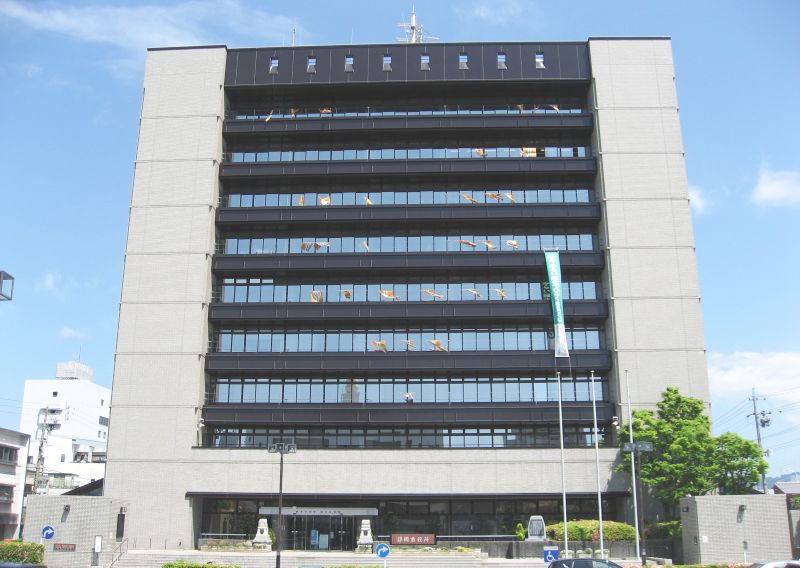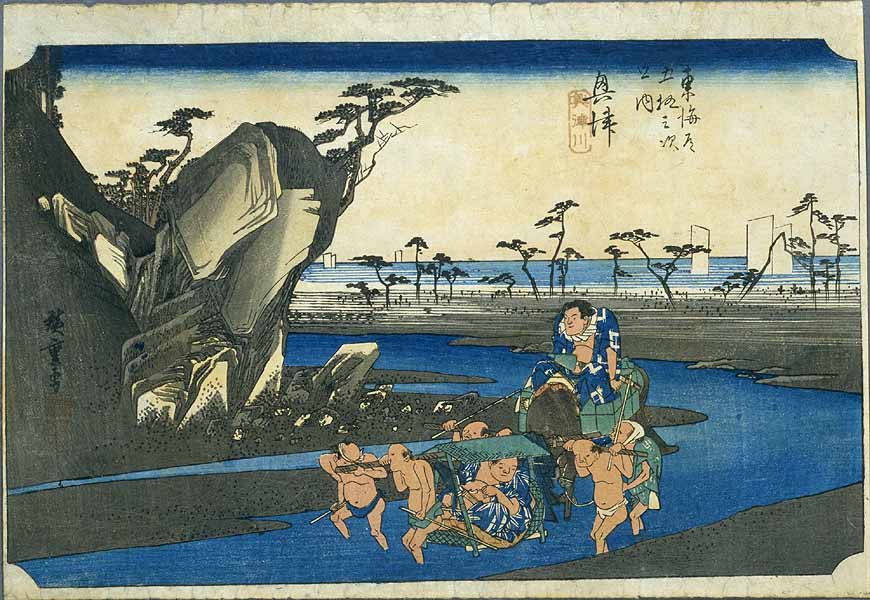|
Shimizu-ku, Shizuoka
is the easternmost of the three wards of the city of Shizuoka in Shizuoka Prefecture, Japan. History Shimizu-ku was created on April 1, 2005, when Shizuoka became a city designated by government ordinance (a "designated city"). Its area is almost identical to former Shimizu city, which merged with Shizuoka city on April 1, 2003. Shizuoka annexed the town of Kanbara from Ihara District on March 31, 2006, and the town of Yui on November 1, 2008, adding these former municipalities to Shimizu-ku. Since ancient times, Shimizu thrived as a harbor town due to its good natural harbor. In addition, five post stations of Tōkaidō were located in Shimizu: ( Kanbara-juku, Okitsu-juku, Ejiri-juku, and Yui-shuku, all of which brought prosperity to the area during the Edo period. After the Meiji Restoration, an Imperial decree in July 1899 established Shimizu as an open port for trading with the United States and the United Kingdom.US Department of State. (1906) ''A digest of int ... [...More Info...] [...Related Items...] OR: [Wikipedia] [Google] [Baidu] |
Wards Of Japan
A is a subdivision of the cities of Japan that are large enough to have been designated by government ordinance. Chapter 17: Government System (Retrieved on July 4, 2009) Wards are used to subdivide each city designated by government ordinance ("designated city"). The 23 special wards of Tokyo Metropolis have a |
Merger And Dissolution Of Municipalities Of Japan
can take place within one municipality or between multiple municipalities and are required to be based upon consensus. History There have been waves of merger activity between Japanese municipalities. The first merger, known as , had happened in the period from 1888 to 1889, when the modern municipal system was established. Before the mergers, existing municipalities were the direct successors of spontaneous hamlets called , or villages under the han system. The rump han system is still reflected in the postal system for rural areas as postal units called . The mergers slashed ‘natural settlements’ (shizen sh¯uraku) that existed at the time from 71,314 to 15,859 cities, towns and villages, justified at the time by the increased scale and relevance of the resulting respective autonomous governing bodies. The second peak, called , took place over the period from 1953 to 1956. It reduced the number of cities, towns and villages by over half, from 9,868 to 3,472 with purposes ... [...More Info...] [...Related Items...] OR: [Wikipedia] [Google] [Baidu] |
United Kingdom
The United Kingdom of Great Britain and Northern Ireland, commonly known as the United Kingdom (UK) or Britain, is a country in Europe, off the north-western coast of the European mainland, continental mainland. It comprises England, Scotland, Wales and Northern Ireland. The United Kingdom includes the island of Great Britain, the north-eastern part of the island of Ireland, and many List of islands of the United Kingdom, smaller islands within the British Isles. Northern Ireland shares Republic of Ireland–United Kingdom border, a land border with the Republic of Ireland; otherwise, the United Kingdom is surrounded by the Atlantic Ocean, the North Sea, the English Channel, the Celtic Sea and the Irish Sea. The total area of the United Kingdom is , with an estimated 2020 population of more than 67 million people. The United Kingdom has evolved from a series of annexations, unions and separations of constituent countries over several hundred years. The Treaty of Union between ... [...More Info...] [...Related Items...] OR: [Wikipedia] [Google] [Baidu] |
United States
The United States of America (U.S.A. or USA), commonly known as the United States (U.S. or US) or America, is a country primarily located in North America. It consists of 50 U.S. state, states, a Washington, D.C., federal district, five major unincorporated territories, nine United States Minor Outlying Islands, Minor Outlying Islands, and 326 Indian reservations. The United States is also in Compact of Free Association, free association with three Oceania, Pacific Island Sovereign state, sovereign states: the Federated States of Micronesia, the Marshall Islands, and the Palau, Republic of Palau. It is the world's List of countries and dependencies by area, third-largest country by both land and total area. It shares land borders Canada–United States border, with Canada to its north and Mexico–United States border, with Mexico to its south and has maritime borders with the Bahamas, Cuba, Russia, and other nations. With a population of over 333 million, it is the List of ... [...More Info...] [...Related Items...] OR: [Wikipedia] [Google] [Baidu] |
Meiji Restoration
The , referred to at the time as the , and also known as the Meiji Renovation, Revolution, Regeneration, Reform, or Renewal, was a political event that restored practical imperial rule to Japan in 1868 under Emperor Meiji. Although there were ruling emperors before the Meiji Restoration, the events restored practical abilities and consolidated the political system under the Emperor of Japan. The goals of the restored government were expressed by the new emperor in the Charter Oath. The Restoration led to enormous changes in Japan's political and social structure and spanned both the late Edo period (often called the Bakumatsu) and the beginning of the Meiji era, during which time Japan rapidly industrialized and adopted Western ideas and production methods. Foreign influence The Japanese knew they were behind the Western powers when US Commodore Matthew C. Perry came to Japan in 1853 in large warships with armaments and technology that far outclassed those of Japan, wit ... [...More Info...] [...Related Items...] OR: [Wikipedia] [Google] [Baidu] |
Edo Period
The or is the period between 1603 and 1867 in the history of Japan, when Japan was under the rule of the Tokugawa shogunate and the country's 300 regional ''daimyo''. Emerging from the chaos of the Sengoku period, the Edo period was characterized by economic growth, strict social order, isolationist foreign policies, a stable population, perpetual peace, and popular enjoyment of arts and culture. The period derives its name from Edo (now Tokyo), where on March 24, 1603, the shogunate was officially established by Tokugawa Ieyasu. The period came to an end with the Meiji Restoration and the Boshin War, which restored imperial rule to Japan. Consolidation of the shogunate The Edo period or Tokugawa period is the period between 1603 and 1867 in the history of Japan, when Japan was under the rule of the Tokugawa shogunate and the country's regional ''daimyo''. A revolution took place from the time of the Kamakura shogunate, which existed with the Tennō's court, to th ... [...More Info...] [...Related Items...] OR: [Wikipedia] [Google] [Baidu] |
Yui-shuku
was the sixteenth of the fifty-three stations of the Tōkaidō. It is located in the Shimizu-ku area of Shizuoka, Shizuoka Prefecture, Japan. It is one of four former post stations located in Shimizu-ku. Area information At the ''Tōkaidō Yui-shuku Omoshiro Shukubakan'', visitors can experience various aspects of life in the Edo period ''shukuba'', ranging from schooling and lodging, to working and socializing. The area is known for its ''sakura ebi'', a type of small shrimp.Yui . JAPANiCAN. Accessed October 26, 2007. In the classic print by (Hōeidō ed ... [...More Info...] [...Related Items...] OR: [Wikipedia] [Google] [Baidu] |
Ejiri-juku
was the eighteenth of the fifty-three stations of the Tōkaidō. It is one of four former post stations located in what is now part of the Shimizu-ku area of Shizuoka, Shizuoka Prefecture, Japan. It was 3.4 kilometers from Okitsu-juku, the preceding post station. History Ejiri-juku was Ejiri Castle's castle town. The castle was built in 1570, but Ejiri-juku was not officially designated a post station until the early 17th century. At its peak, it had two ''honjin'', three sub-''honjin'' and 50 ''hatago'', among the 1,340 total buildings. Its population was around 6,500.53 Stations of the Tōkaidō - Ejiri-juku . Kōhei Wada. Accessed November 9, 2007. Ejiri-juku gave its name to the area's railway station, until it was renamed [...More Info...] [...Related Items...] OR: [Wikipedia] [Google] [Baidu] |
Okitsu-juku
was the seventeenth of the fifty-three stations of the Tōkaidō. It is located in what is now part of the Shimizu-ku area of Shizuoka, Shizuoka Prefecture, Japan. History Okitsu-juku was established in 1601, just before the beginning of the Edo period. At its peak, there were approximately 316 buildings and 1,668 people. Among the buildings were two ''honjin'', two sub-''honjin'' and 34 ''hatago''. It was a little over 11 kilometers from the preceding post station, Yui-shuku. The classic ukiyo-e print by Andō Hiroshige (''Hōeidō'' edition) from 1831–1834 depicts two sumo is a form of competitive full-contact wrestling where a '' rikishi'' (wrestler) attempts to force his opponent out of a circular ring ('' dohyō'') or into touching the ground with any body part other than the soles of his feet (usually by ... wrestlers being carried across the Okitsu River, one on a packhorse and the other in a '' kago''. Neighboring post towns ;Tōkaidō : Yui-shuku - O ... [...More Info...] [...Related Items...] OR: [Wikipedia] [Google] [Baidu] |
Kanbara-juku
was the fifteenth of the fifty-three stations of the Tōkaidō. It is located in what is now part of the Shimizu-ku ward of Shizuoka, Shizuoka Prefecture, Japan. It is one of four former post stations located in Shimizu-ku. History The original Kanbara-juku was decimated by a flood in the early part of the Edo period, but was rebuilt shortly thereafter.Kanbara-juku ~ Yui-shuku Accessed November 5, 2007. The classic print by (Hōeidō edition) from 1831–1834, depicts a mountain village at nightfall, through which three people are struggling under deep snow. I ... [...More Info...] [...Related Items...] OR: [Wikipedia] [Google] [Baidu] |
Tōkaidō (road)
The , which roughly means "eastern sea route," was the most important of the Five Routes of the Edo period in Japan, connecting Kyoto to Edo (modern-day Tokyo). Unlike the inland and less heavily travelled Nakasendō, the Tōkaidō travelled along the sea coast of eastern Honshū, hence the route's name. Traveling the Tōkaidō The standard method of travel was on foot, as wheeled carts were almost nonexistent and heavy cargo was usually sent by boat. Members of the higher class, however, travelled by '' kago''. Women were forbidden to travel alone and had to be accompanied by men. Other restrictions were also put in place for travellers, but, while severe penalties existed for various travel regulations, most seem not to have been enforced. Captain Sherard Osborn, who travelled part of the road in around 1858, noted that: Along the Tōkaidō, there were government-sanctioned post stations (shukuba) for travellers' rest. These stations consisted of porter stations and hors ... [...More Info...] [...Related Items...] OR: [Wikipedia] [Google] [Baidu] |
Shukuba
were post stations during the Edo period in Japan, generally located on one of the Edo Five Routes or one of its sub-routes. They were also called ''shuku-eki'' (宿駅). These post stations (or "post towns") were places where travelers could rest on their journey around the nation. They were created based on policies for the transportation of goods by horseback that were developed during the Nara and Heian periods. History These post stations were first established by Tokugawa Ieyasu shortly after the end of the Battle of Sekigahara. The first post stations were developed along the Tōkaidō (followed by stations on the Nakasendō and other routes). In 1601, the first of the Tōkaidō's fifty-three stations were developed, stretching from Shinagawa-juku in Edo to Ōtsu-juku in Ōmi Province. Not all the post stations were built at the same time, however, as the last one was built in 1624. The lodgings in the post stations were established for use by public officials an ... [...More Info...] [...Related Items...] OR: [Wikipedia] [Google] [Baidu] |






.jpg)